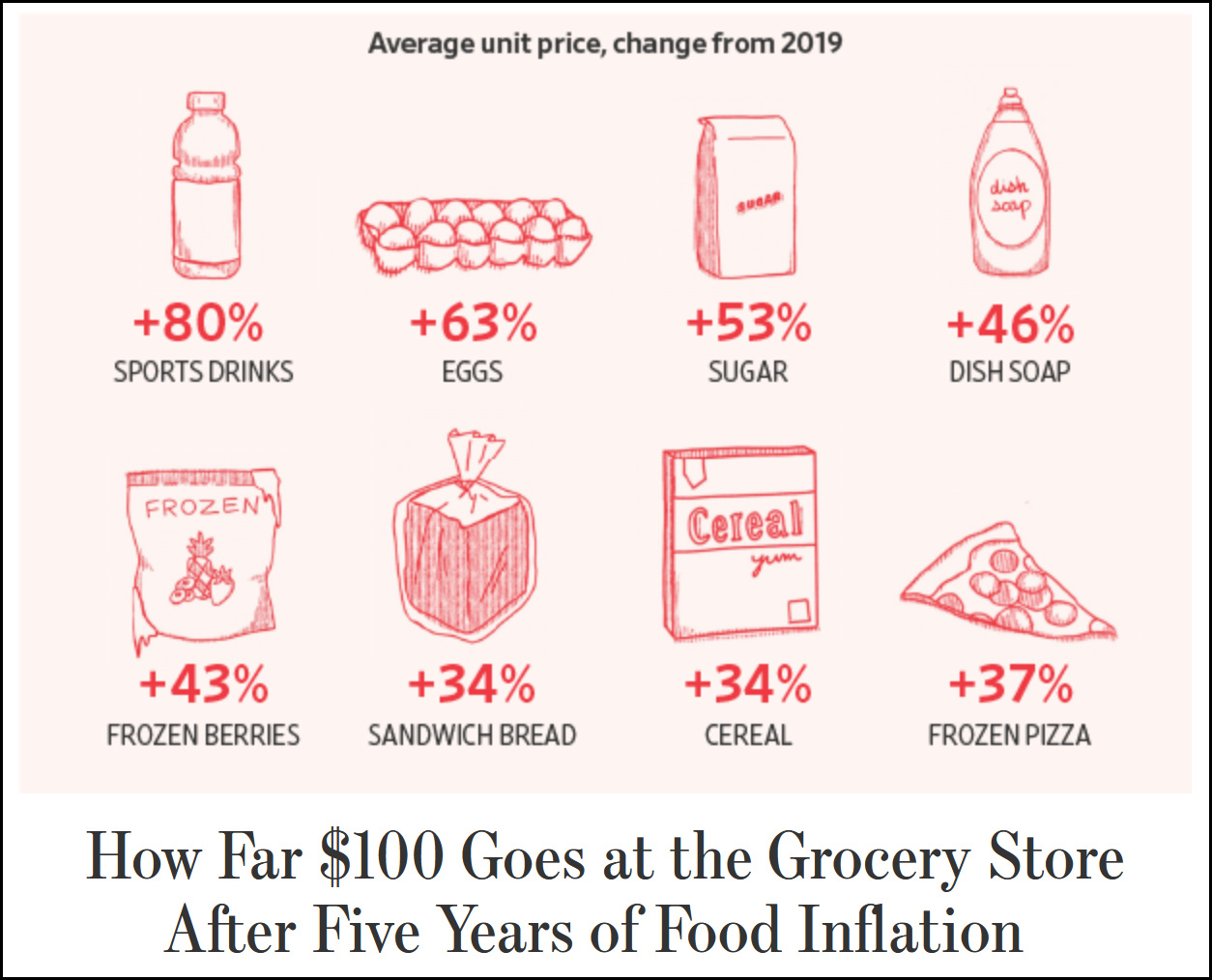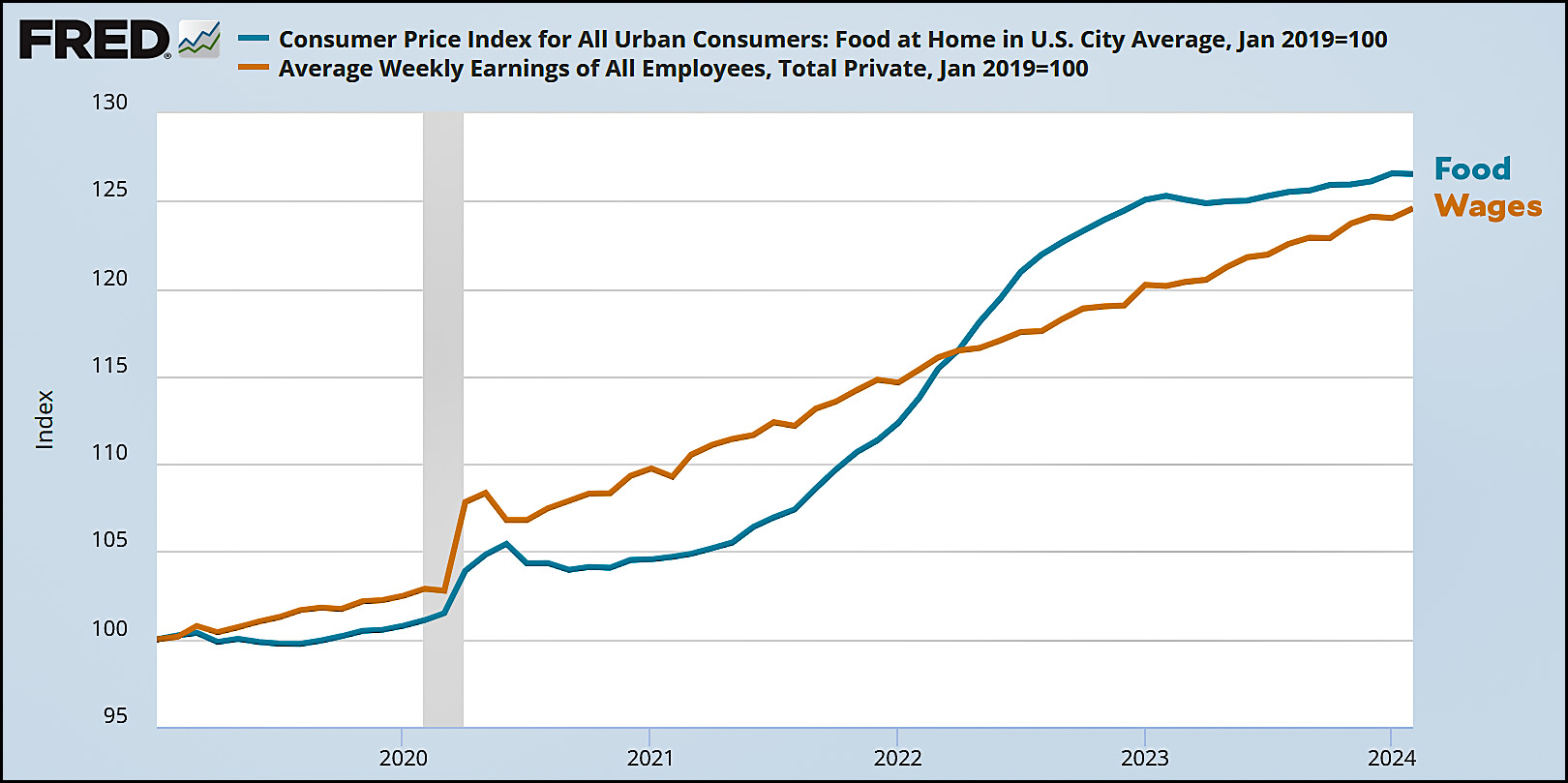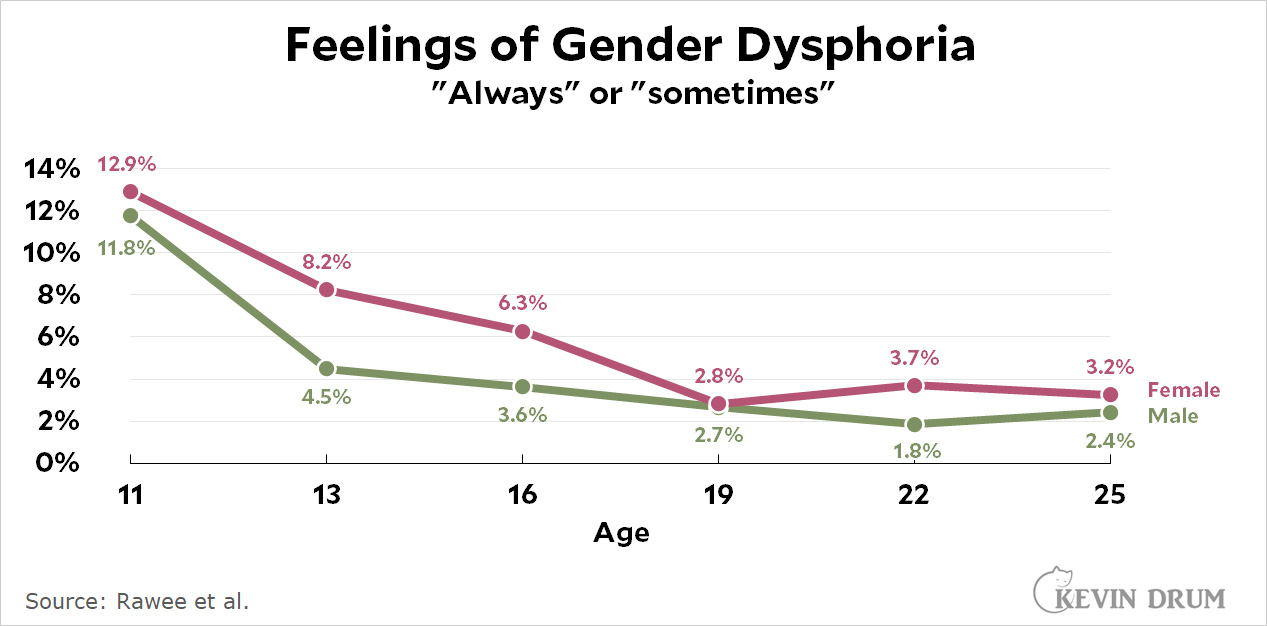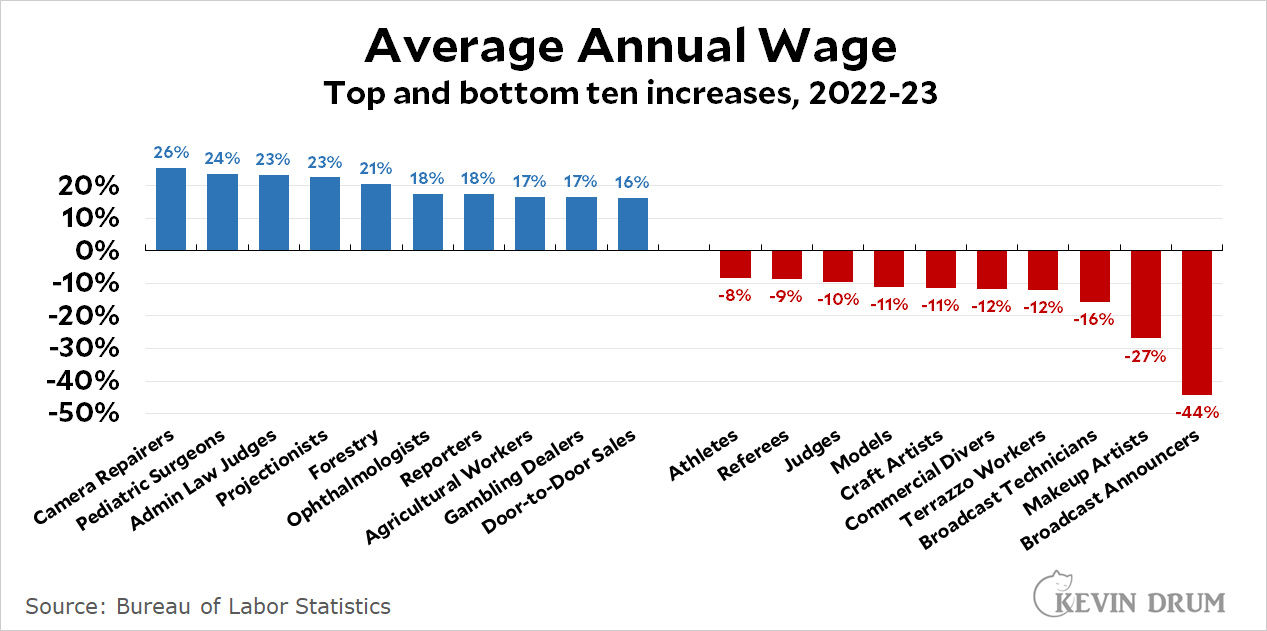Sunrise at the Mexican border.

Cats, charts, and politics

In the Guardian today, April McGreger writes about her son's kindergarten, which has cut lunchtime to 15 minutes and requires kids to remain silent the entire time:
When I questioned this policy, his teacher told me the short lunches allowed more time for electives and special academic programming that made their school best in its class. The intent was to maximize instructional time for the school’s prized technology and Spanish lessons — in theory, a good idea. That meant shaving minutes off other activities, and the school found that 15 minutes was not enough time to eat if the children were allowed to talk.
These are five-year-olds. This is insane. It's astonishing what people can talk themselves into when they become too insular.
I have perfect timing. Yesterday I noted that even though overall food inflation is low, there are still some items that have increased a lot. Today, the Wall Street Journal splashes this exact thing across their front page:
 "Calm down, Kevin," some of you are already saying. "Read past the headline and I'm sure they compare average food prices to wages. The Journal is a serious paper."
"Calm down, Kevin," some of you are already saying. "Read past the headline and I'm sure they compare average food prices to wages. The Journal is a serious paper."
Astonishingly enough, no. There is not so much as a mention of wages in the piece. In fact, they exaggerate food inflation by cherry picking a basket of items that have gone up more than average. Here's the real story:
 Since 2019, the overall cost of groceries has increased 1.5% more than average wages.
Since 2019, the overall cost of groceries has increased 1.5% more than average wages.
That's not a typo. 1.5%.
That's all but unnoticeable. And, I suppose, nowhere near scary enough for the front page of the Journal. They should be ashamed of themselves.
There are several things that are more or less undisputed about the Israeli airstrike that killed seven aid workers in Gaza:

So the only remaining question is: Why? Did the Israeli military deliberately destroy an aid convoy? Or, despite everything, did they somehow misidentify the trucks as Hamas?
I can hardly bring myself to believe it was deliberate. That would be monstrous. On the other hand, Israel's ongoing efforts to starve the Gazan population have been pretty monstrous. What's more, their recent acquiescence to increasing aid shipments has been very much against their will. Deliberately destroying an aid convoy would certainly be a very effective way of continuing their starvation policy by the simple expedient of scaring off humanitarian organizations. Finally, in addition to all this, it's just very hard to believe that an operation so precisely calculated and carried out was due merely to sloppy intel or a careless fog-of-war mistake.
I still don't believe it was deliberate. I can't. But it sure is getting harder.
How many children experience a desire to be the opposite sex—a feeling known as gender dysphoria? Of those who do, how many continue to experience it as they get older? A recent paper provides answers based on a longitudinal study of 2,200 children in the Netherlands that was carried out between 2001 and 2015:
 As you can see, gender dysphoria was most common at age 11 and fell steadily until age 19, at which point it plateaued. The authors found that, overall, 78% of the children never experienced gender dysphoria; 19% experienced gender dysphoria that declined with age; and 2% experienced gender dysphoria that increased with age.
As you can see, gender dysphoria was most common at age 11 and fell steadily until age 19, at which point it plateaued. The authors found that, overall, 78% of the children never experienced gender dysphoria; 19% experienced gender dysphoria that declined with age; and 2% experienced gender dysphoria that increased with age.
By age 25, the share of people who felt gender dysphoria "always" was 0.75% for men and 0.5% for women.
Both increasing and decreasing gender dysphoria were associated with mental health issues:
Low global self-worth was found to be associated with having an increasing or decreasing gender non-contentedness trajectory throughout adolescence.... Individuals with an increasing trajectory of gender non-contentedness had significantly higher YSR/ASR total problem scores at all timepoints
Since this is a longitudinal study, the same children participated in all six waves from age 11 to age 25.
 Why do so many people still think inflation is high? It's because they don't respond to averages. They respond to outliers.
Why do so many people still think inflation is high? It's because they don't respond to averages. They respond to outliers.
The cost of groceries, for example, has risen only 1% over the past year. In February food inflation was negative. And yet, 55% of Americans still say they worry about inflation a great deal. It remains the top concern in the most recent Gallup poll.
One reason for this is that although food inflation might officially be at 1%, that's an average. Here are the top 15 gainers:
 Frozen juice is up 27%. Baby food is up 9%. Ground beef is up 6%. When you shop for groceries, these things are going to stand out.
Frozen juice is up 27%. Baby food is up 9%. Ground beef is up 6%. When you shop for groceries, these things are going to stand out.
Now, it's also true that eggs are down 17%. Apples are down 10%. Fruits, vegetables, chicken, and dozens of other items have been flat. But you don't really notice that. You notice the occasional item that's way higher than it used to be.
And the fact that frozen juice is up largely because of an orange disease in Florida combined with a poor southeast Asian sugar crop? Not one person in a thousand knows that or cares about it. Their mindset is still fixated on inflation, so they see the high price of Minute Maid and automatically blame it on inflation.
That mindset will wane over the next few months as overall grocery bills stay flat for awhile. Until then, if even a few popular items have big price increases lots of people will think inflation is still surging.
This is the Pauma Valley on a hazy day, shot from about halfway up Palomar Mountain. I took this on a rare daytime scouting mission that led me up a progressively rockier road that, toward the end, was only barely passable. It's a good thing I hadn't tried this in my old Mazda. But it was worth it in the end, since it allowed me to find a nice spot near the top of the mountain that I've used ever since for astrophotography. I just get there via a different road.

New York City will soon have a new congestion pricing program. At peak hours, it will cost $15 to enter lower Manhattan by car. Naturally lots of people don't like this, so just as naturally they're suing over it. And naturally naturally, they're suing over allegedly insufficient environmental review:
In court papers, they have challenged the agency’s “decision to rubber-stamp the environmental review phase” of the tolling program based on its “inexplicable finding” that there will be no significant effects, according to court filings.
....Six lawsuits, including New Jersey’s, have been brought against the program in local federal courts. The mayor of Fort Lee, N.J., Mark J. Sokolich, has filed a related lawsuit.
And four additional lawsuits have been brought in New York: one by Ed Day, the Rockland County executive; one by the United Federation of Teachers and Vito Fossella, the Staten Island borough president; and two by separate groups of city residents.
There has to be a way to find some reasonable middle ground on environmental review. Everyone agrees that it's a good concept, but it's also broken. Cities and developers with projects in mind spend years producing thousand page EIRs that might as well get tossed in the trash as soon as they're done. Regardless of how good or bad they are, some well-heeled person or group who objects to a project will claim that the environmental review is inadequate. The fact that judges frequently uphold them suggests that the standards for review are simply too strict.
This all goes under the umbrella rubric of "permitting reform," which gets a lot of attention these days but not much action. This is unfortunate, since the US could use a strong dose of common sense injected into the building process.
The BLS released its latest salary figures today, so I took a look because I was at loose ends. According to their data, the highest paid occupation in America is pediatric surgeon, at $449,320. In fact, physicians in general take 15 of the top 16 spots, with athletes squeezing in at #10.
The lowest paid occupation is shampooer, at $29,260, barely eking out last place over fast food cooks. Four of the bottom ten are restaurant workers.
But what's more interesting is who the big winners and losers were last year. Here are the top and and bottom ten:
 There are some oddities here. Admin law judges are up 23% while judges more generally are down 10%. Considering that judges are public employees with fixed salaries, I'm a little puzzled at how they could have substantial changes in either direction.
There are some oddities here. Admin law judges are up 23% while judges more generally are down 10%. Considering that judges are public employees with fixed salaries, I'm a little puzzled at how they could have substantial changes in either direction.
Camera repairers were up 26%! Who knew? And reporters were up 18%, which is going to come as a big surprise to the reporters I know. On the other hand, it was apparently a bad year for athletes and referees, and a terrible year for broadcast announcers, whose salaries plummeted 44%. But maybe that had something to do with the strike? I'm not sure about the methodology here.